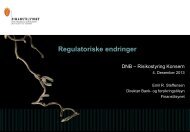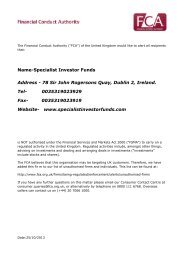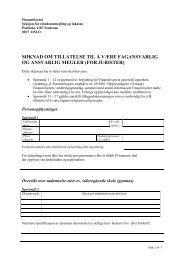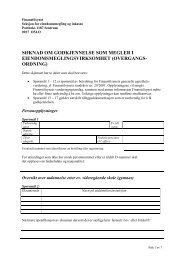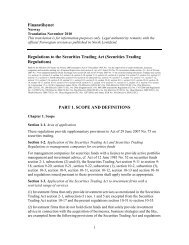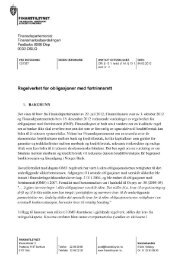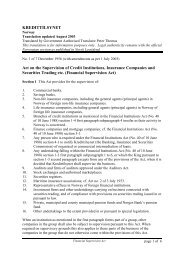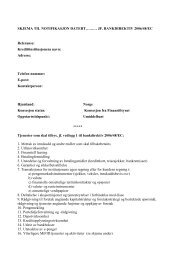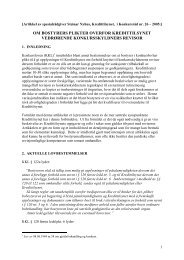Rapport om gjennomføring av AIFMD i norsk rett - Finanstilsynet
Rapport om gjennomføring av AIFMD i norsk rett - Finanstilsynet
Rapport om gjennomføring av AIFMD i norsk rett - Finanstilsynet
You also want an ePaper? Increase the reach of your titles
YUMPU automatically turns print PDFs into web optimized ePapers that Google loves.
EN<br />
L 174/70 Official Journal of the European Union 1.7.2011<br />
ANNEX II<br />
REMUNERATION POLICY<br />
1. When establishing and applying the total remuneration policies, inclusive of salaries and discretionary pension benefits,<br />
for those categories of staff, including senior management, risk takers, control functions and any employee receiving<br />
total remuneration that takes them into the same remuneration bracket as senior management and risk takers, whose<br />
professional activities h<strong>av</strong>e a material impact on the risk profiles of the AIFMs or of AIFs they manage, AIFMs shall<br />
c<strong>om</strong>ply with the following principles in a way and to the extent that is appropriate to their size, internal organisation<br />
and the nature, scope and c<strong>om</strong>plexity of their activities:<br />
(a) the remuneration policy is consistent with and pr<strong>om</strong>otes sound and effective risk management and does not<br />
encourage risk-taking which is inconsistent with the risk profiles, rules or instruments of incorporation of the<br />
AIFs they manage;<br />
(b) the remuneration policy is in line with the business strategy, objectives, values and interests of the AIFM and the<br />
AIFs it manages or the investors of such AIFs, and includes measures to <strong>av</strong>oid conflicts of interest;<br />
(c) the management body of the AIFM, in its supervisory function, adopts and periodically reviews the general<br />
principles of the remuneration policy and is responsible for its implementation;<br />
(d) the implementation of the remuneration policy is, at least annually, subject to central and independent internal<br />
review for c<strong>om</strong>pliance with policies and procedures for remuneration adopted by the management body in its<br />
supervisory function;<br />
(e) staff engaged in control functions are c<strong>om</strong>pensated in accordance with the achievement of the objectives linked to<br />
their functions, independent of the performance of the business areas they control;<br />
(f) the remuneration of the senior officers in the risk management and c<strong>om</strong>pliance functions is directly overseen by<br />
the remuneration c<strong>om</strong>mittee;<br />
(g) where remuneration is performance related, the total amount of remuneration is based on a c<strong>om</strong>bination of the<br />
assessment of the performance of the individual and of the business unit or AIF concerned and of the overall<br />
results of the AIFM, and when assessing individual performance, financial as well as non-financial criteria are<br />
taken into account;<br />
(h) the assessment of performance is set in a multi-year framework appropriate to the life-cycle of the AIFs managed<br />
by the AIFM in order to ensure that the assessment process is based on longer term performance and that the<br />
actual payment of performance-based c<strong>om</strong>ponents of remuneration is spread over a period which takes account<br />
of the redemption policy of the AIFs it manages and their investment risks;<br />
(i) guaranteed variable remuneration is exceptional, occurs only in the context of hiring new staff and is limited to<br />
the first year;<br />
(j) fixed and variable c<strong>om</strong>ponents of total remuneration are appropriately balanced and the fixed c<strong>om</strong>ponent<br />
represents a sufficiently high proportion of the total remuneration to allow the operation of a fully flexible<br />
policy, on variable remuneration c<strong>om</strong>ponents, including the possibility to pay no variable remuneration<br />
c<strong>om</strong>ponent;<br />
(k) payments related to the early termination of a contract reflect performance achieved over time and are designed in<br />
a way that does not reward failure;<br />
(l) the measurement of performance used to calculate variable remuneration c<strong>om</strong>ponents or pools of variable<br />
remuneration c<strong>om</strong>ponents includes a c<strong>om</strong>prehensive adjustment mechanism to integrate all relevant types of<br />
current and future risks;<br />
(m) subject to the legal structure of the AIF and its rules or instruments of incorporation, a substantial portion, and in<br />
any event at least 50 % of any variable remuneration consists of units or shares of the AIF concerned, or<br />
equivalent ownership interests, or share-linked instruments or equivalent non-cash instruments, unless the<br />
management of AIFs accounts for less than 50 % of the total portfolio managed by the AIFM, in which case<br />
the minimum of 50 % does not apply.<br />
The instruments referred to in this point shall be subject to an appropriate retention policy designed to align<br />
incentives with the interests of the AIFM and the AIFs it manages and the investors of such AIFs. Member States<br />
or their c<strong>om</strong>petent authorities may place restrictions on the types and designs of those instruments or ban certain<br />
instruments as appropriate. This point shall be applied to both the portion of the variable remuneration<br />
c<strong>om</strong>ponent deferred in line with point (n) and the portion of the variable remuneration c<strong>om</strong>ponent not deferred;



